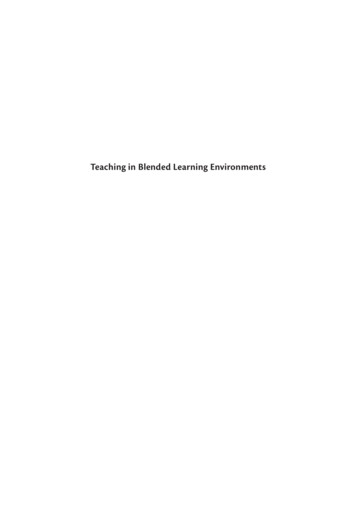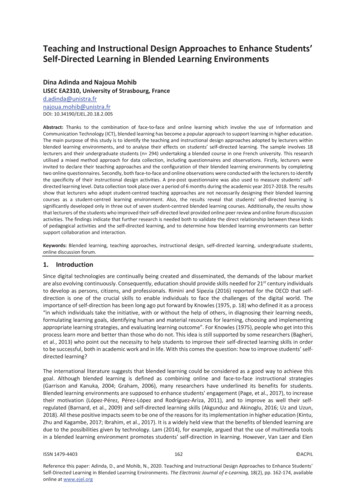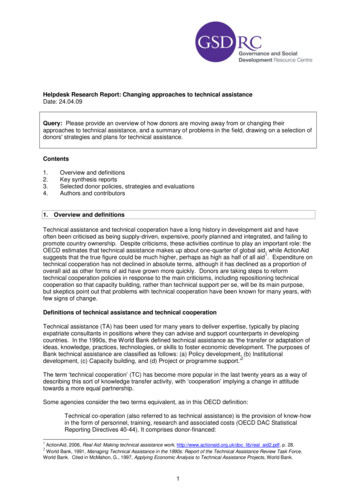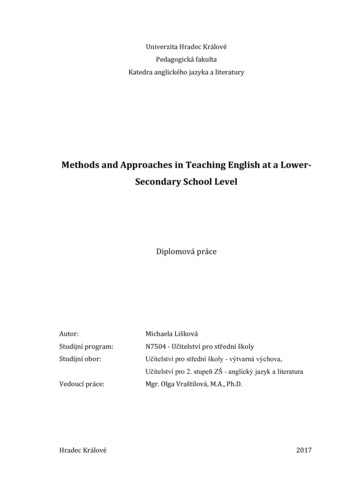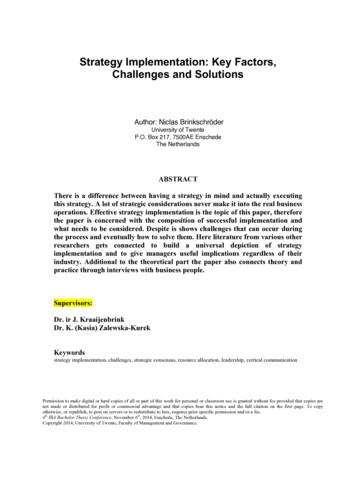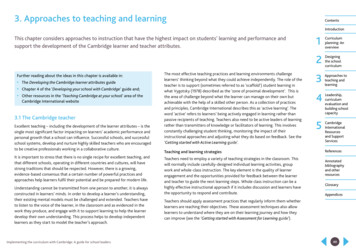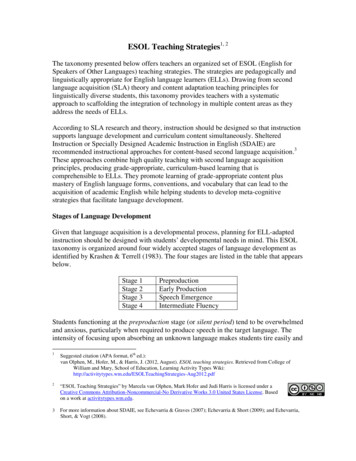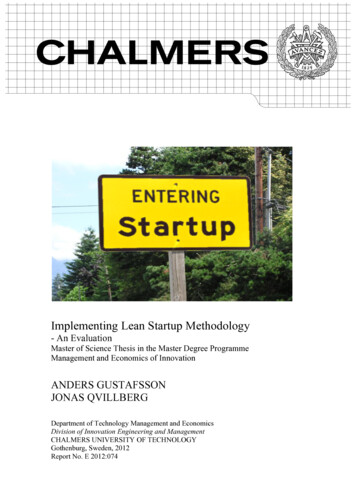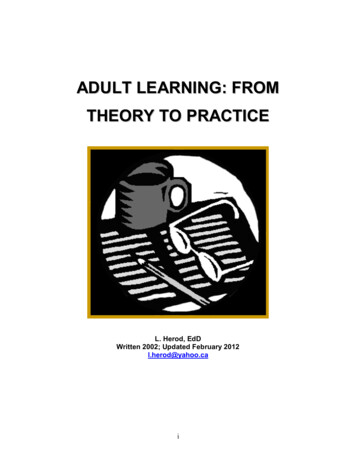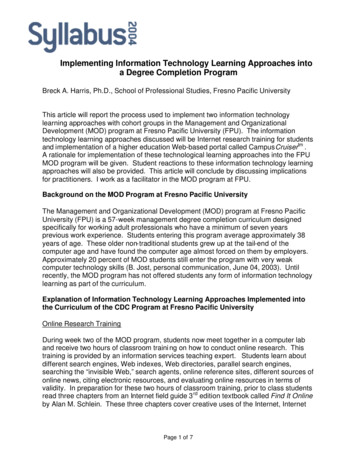
Transcription
Implementing Information Technology Learning Approaches intoa Degree Completion ProgramBreck A. Harris, Ph.D., School of Professional Studies, Fresno Pacific UniversityThis article will report the process used to implement two information technologylearning approaches with cohort groups in the Management and OrganizationalDevelopment (MOD) program at Fresno Pacific University (FPU). The informationtechnology learning approaches discussed will be Internet research training for studentsand implementation of a higher education Web-based portal called CampusCruisertm .A rationale for implementation of these technological learning approaches into the FPUMOD program will be given. Student reactions to these information technology learningapproaches will also be provided. This article will conclude by discussing implicationsfor practitioners. I work as a facilitator in the MOD program at FPU.Background on the MOD Program at Fresno Pacific UniversityThe Management and Organizational Development (MOD) program at Fresno PacificUniversity (FPU) is a 57-week management degree completion curriculum designedspecifically for working adult professionals who have a minimum of seven yearsprevious work experience. Students entering this program average approximately 38years of age. These older non-traditional students grew up at the tail-end of thecomputer age and have found the computer age almost forced on them by employers.Approximately 20 percent of MOD students still enter the program with very weakcomputer technology skills (B. Jost, personal communication, June 04, 2003). Untilrecently, the MOD program has not offered students any form of information technologylearning as part of the curriculum.Explanation of Information Technology Learning Approaches Implemented intothe Curriculum of the CDC Program at Fresno Pacific UniversityOnline Research TrainingDuring week two of the MOD program, students now meet together in a computer laband receive two hours of classroom traini ng on how to conduct online research. Thistraining is provided by an information services teaching expert. Students learn aboutdifferent search engines, Web indexes, Web directories, parallel search engines,searching the “invisible Web,” search agents, online reference sites, different sources ofonline news, citing electronic resources, and evaluating online resources in terms ofvalidity. In preparation for these two hours of classroom training, prior to class studentsread three chapters from an Internet field guide 3 rd edition textbook called Find It Onlineby Alan M. Schlein. These three chapters cover creative uses of the Internet, InternetPage 1 of 7
terminology and concepts, and how to frame a search strategy on the Internet (Schlein,2003).MOD students use this Internet research training to complete 11 Internet researchassignments that are due on a weekly basis during the following 23 weeks of theprogram. These assignments provide students with the opportunity to apply the Internetresearch training they receive on their own computer. Each Internet researchassignment requires students to provide two titles and Web addresses on an assignedtopic. The student briefly summarizes what he/she learned from each site visited, howvisiting the site changed their previous view on the topic, and explains the validity ofeach source (see Appendix). Development of these Internet research skills alsoassists MOD students when they conduct online literature searches to find books andarticles needed for their baccalaureate thesis project.CampusCruisertmCampusCruisertm is a Web-based higher education enterprise portal incorporating useof the Internet that allows colleges and universities the ability to provide different studentservices and academic administration and learning. Currently, over 100 colleges anduniversities nationally use CampusCruisertm (B. Sharpton, personal communication,June 04, 2003). CampusCruisertm provides an online communication platform formanaging, tracking, and sharing information with tools such as e-mail, message boards,discussion groups, and publishing features, all in one unified system that operates 24hours a day, seven days a week. This Web-based higher education portal is designedto allow faculty increased communication with students regarding course work, classassignments, office hours, and learning initiatives. CampusCruisertm also allowsstudents immediate access to transcripts and grades, and connection with classmatesthrough e-mail. Students can also check on homework assignments, access campusnews, and even download extensive curriculum (CampusCruisertm, 2003).Rationale for Implementation of Information Technology Learning Approachesinto the Curriculum of the CDC Program at Fresno Pacific UniversityThree major reasons support implementation of information technology learningapproaches into the curriculum of the CDC Program at Fresno Pacific University. Thethree reasons are: 1) preparing MOD graduates become part of the global economy, 2)preparing MOD graduates for increasingly computerized work environments, and 3)MOD program administration cost savings. These three reasons are explained in moredetail below:Preparing MOD Graduates to Become Part of the Global Economy. The computer asan information tool is transforming the economies and cultures of the entire world. Theworld is becoming a smaller “global village” characterized by people of different nationsusing the computer as an instant medium to do business with and learn from eachother.Page 2 of 7
MOD students need to learn to use the computer as an information tool for gainingknowledge. This knowledge will prepare future MOD graduates to participate in thisworld-wide technological revolution that is taking place.Preparing future MOD Graduates for increasingly Computerized Work Environments.MOD students are increasingly finding that they must develop the flexibility to transitionquickly into a constantly changing business world that is being increasinglycomputerized. National job trends indicate the need for MOD graduates to obtain skillsin learning and use of computer technology. For example, it was recently reported that56 percent of adult workers nationally are now “wired” and use computers as part oftheir work. Approximately 80.5 percent of people in managerial and professionalspecialty occupations use a computer at work (U.S. Department of Commerce, 2002).Based on these job trends, knowledge and use of computer technology has alreadybecome a common work requirement for many management professionals.MOD Program Administration Cost Savings. The transition to information technologyapproaches such as the CampusCruisertm portal provides significant cost savingsassociated with administration of the MOD program. For example, MOD students arenow using CampusCruisertm to individually download MOD curriculum from the Webportal directly to their personal computers and printers. MOD administrative staff are nolonger required to spend the time required to copy hundreds of pages of MODcurriculum, place the copied curriculum into individual binders, and distribute thebinders to students. Other ways that CampusCruisertm provides cost savings is thatMOD students are now being directed to go online through the Fresno Pacific Universitylibrary and download management articles on the Internet. Many of these articlespreviously required MOD program administrators to pay a copyright fee to the authors.However, these fees are no longer required since many of these same articles on theInternet are now legally considered part of the public domain.MOD Student Reactions to Implementation of Information Technology LearningApproaches into the MOD Program at FPUBeginning in February of 2003, all new MOD cohorts began to receive online researchtraining and using CampusCruisertm The following discussion will summarize thereactions of MOD students to use of these two information technology learningapproaches. Student reactions were gathered from discussions I had with other MODprofessors leading new MOD cohort groups using CampusCruisertm, and by ownperceptions using CampusCruisertm to interact with my students.Online Research Training. Generally, MOD students have been very positive about theonline research training they have received. This training has been very successful inhelping MOD students complete 11 Internet research assignments required during thefirst six months of the program. Increased knowledge of online research training hasalso assisted MOD students to identify literature sources for their baccalaureate thesisproject, and improved their overall learning in the MOD program.Page 3 of 7
Student Reactions to use of CampusCruisertm. MOD student reactions in the first twocohorts using CampusCruisertm were initially mixed. However, later MOD cohorts havereported few problems with effectively learning and using CampusCruisertm (D.Langhofer, personal communication, June 28, 2003).A few MOD students have expressed dislike for the additional time and/or printingexpense required to individually download MOD curriculum from CampusCruisertm . Inrecent cohort groups, students have generally shared enthusiastic appreciation for thedifferent communication qualities of CampusCruisertm. For example, students attendingclass in the evening at FPU now feel more “connected” to the student life of theuniversity because when they first log on to CampusCruisertm , they are brought to ascreen where they can read and learn about recent university news or announcements.Students also have expressed satisfaction about the improved ability for receivingonline grades on weekly assignments in a timely manner.Instructor Reactions to using Campus CruisertmI am using the CampusCruisertm e-mail feature to instantly communicate importantinformation to my classes. This feature of CampusCruisertm has significantly improvedmy ability to communicate effectively with my students outside of the classroom setting.I have also used CampusCruisertm to create asynchronous threaded discussions onvarious class topics. With this approach, I can go online and post a question on theCampusCruisertm class message board related to the weekly reading. During the week,students can respond to a question and continue the “thread” of online conversationwith other students in their class. This asynchronous approach allows students theopportunity to reply at anytime during the week according to their own personalschedules. Many of my students are actually more comfortable with this “space-free”form of dialogue versus the traditional face-to-face classroom experience.CampusCruisertm is a very effective tool for entering grades for students. For each ofmy college classes, I can now easily create separate assignments with an associatedgrading scale. I can also quickly create individual journals, syllabi, and announcementsfor each of my classes. Another excellent time-saving feature of Campuscruisertm is theability to upload class assignments, grading schemes, and other grading features fromprevious classes I have taught to a new class I have just started. This saves mevaluable time by not having to create identical grading schemes for each new class.Implications for PractitionersIn the future, the use of information technology approaches in curriculum offered toadults will be increasingly common. However, I still believe that adult students canbenefit synergistically from the traditional classroom e xperience, where studentsexperience real-time learning while interacting with both the teacher and other studentsin a face-to-face dialogical setting. Where will the world of high-tech and human touchmeet in terms of best meeting the learning needs of future adult students? Where willthese two worlds collide? The answers to these questions are not presently clear.Page 4 of 7
More research is needed to address these type of questions. However, I believe someconstructive combination of the worlds of high-tech and high-touch offers the bestsolution to offer transformative learning for future adult students. Finding that effectivehybrid of “clicks and bricks,” or effectively mixing a combination of human touch (thetraditional classroom setting) with human technology (cyberspace learning) presentsinteresting learning challenges for entire field of adult education.ReferencesCampusCruisertm: What will CampusCruisertm do for me? (n.d.). Retrieved May02, 2003 from http://www.campuscruiser/com/cc what benefits.html.Schlein, A.M. (2003). Find it online (3rd edition). Tempe, AZ: Facts on DemandPress.U.S. Department of Commerce Digital Divide Report (2002). A Nation Online;Americans Are Expanding Their Use of the Internet (chap. 6) [Online].Available: s/index.cfm?key 210[Retrieved May 23, 2003].Page 5 of 7
AppendixMOD Internet Research AssignmentStudent Name:Topic ofResearch:Date:Time spent on this research:Below consider two articles that you found valuable for information related to thetopic assigned. You must give enough information that the topic and importance ofyour research is clear to the reader. This assignment has a value of two points.Article One Title AuthorWeb address1. What specifically was this article about?82. How did it change your view on this topic?3. Explain the validity of this article.Article Two, Title AuthorWeb address1. What specifically was this article about?2.How did it change your view on this topic?Page 6 of 7
3.Explain the validity of this article.Page 7 of 7
Development (MOD) program at Fresno Pacific University (FPU). The information technology learning approaches discussed will be Internet research training for students and implementation of a higher education Web -based portal called Campus Cruisertm . A rationale for implementation of these techno
